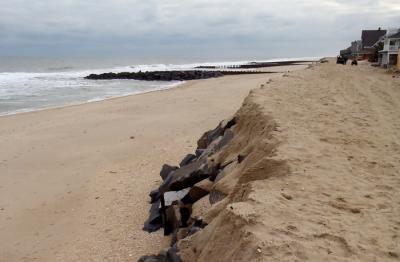By the time Sandy hit New Jersey and New York, it had been reduced to a tropical storm but its rare angle of approach still meant a lot of devastation.
Environmentalists in New York are resistant to creating barriers against future storms, like subway doors that can prevent flooding, and seawalls, but the stories of two residential beach communities on the New Jersey shore provide compelling evidence.
Bay Head and Mantoloking sit side-by-side in Ocean County on a narrow barrier island that separates the Atlantic Ocean and Barnegat Bay. What newspaper editors came to call Super Storm Sandy landed on Oct. 29th, 2012, and before then a driver traveling north on Ocean Avenue would go from Mantoloking into Bay Head and notice little different about the residential development, dunes, beaches, and shoreline.
The difference was hidden under the sand. A 1,260-meter seawall built in 1882.
The seawall helped Bay Head weather Sandy's record storm surges and large waves over multiple high tides, according to a team of engineers and geoscientists led by Jennifer L. Irish, an associate professor of civil and environmental engineering at Virginia Tech.
The reappearance of the stone structure surprised many area residents, all the more reason not to let transient communities and environmentalists latching onto disasters dictate how the public should be protected. 150 years ago community planners never heard of global warming but they knew about hurricanes.
The story of the tiny, forgotten seawall illustrates the need for multi-levels of beach protection in oceanfront communities, the researchers said.
All oceanfront homes in the two boroughs were damaged, ranging from ground-floor flooding to complete destruction. As measured by water lines on the interior of homes, flooding was similar in both boroughs. The difference was the extent of the storm's impact.
In Mantoloking, the entire dune almost vanished. Water washed over the barrier spit and opened three breaches of 165 meters, 59 meters, and 35 meters, where the land was swept away. In Bay Head, only the portion of the dune located seaward of the seawall was eroded and the section of dune behind the seawall received only minor local scouring.
Researchers classified 88 percent of the oceanfront homes in Bay Head as flooded, with just one oceanfront home destroyed. In Mantoloking, more than half of the oceanfront homes were classified as damaged or destroyed.

A 1,260-meter seawall buried beneath the beach helped Bay Head weather Sandy's record storm surges and large waves over multiple high tides, according to a team of engineers and geoscientists. Credit: Jennifer Irish/Virginia Tech
"Once we got there, we immediately saw the seawall," Irish said. "The beach and dunes did their job to a certain point, then, the seawall took over, providing significant dampening of the waves. It was the difference between houses that were flooded in Bay Head and houses that were reduced to piles of rubble in Mantoloking."
With recovery efforts under way and storms still circulating through the area, Irish and Robert Weiss, an assistant professor of geosciences at Virginia Tech, with Patrick Lynett, an associate professor of civil and environmental engineering at the University of Southern California, documented high water marks, damage, overwash, and breaches of the barrier island.
Later, using Google Earth to evaluate aerial images taken two years before and immediately after Hurricane Sandy, the research team evaluated houses, labeling a structure with a different roofline as damaged, one that no longer sits on its foundation as destroyed, and the remaining houses as flooded.
Despite the immense magnitude and duration of the storm, a relatively small coastal obstacle reduced potential wave loads by a factor of two and was the difference between widespread destruction and minor structural impacts, the researchers said.
"We have a great deal of compassion for the people who have had to endure the devastation of Hurricane Sandy in Bay Head and Mantoloking," Irish said. "It will have little solace, but we are left with a clear, unintentional example of the need for multiple levels of defense that include hard structures and beach nourishment to protect coastal communities."
Citation: Jennifer L. Irish, Patrick J. Lynett , Robert Weiss, Stephanie M. Smallegan, Wei Cheng, 'Buried relic seawall mitigates Hurricane Sandy's impacts', Coastal Engineering Volume 80, October 2013, Pages 79–82 http://dx.doi.org/10.1016/j.coastaleng.2013.06.001




Comments